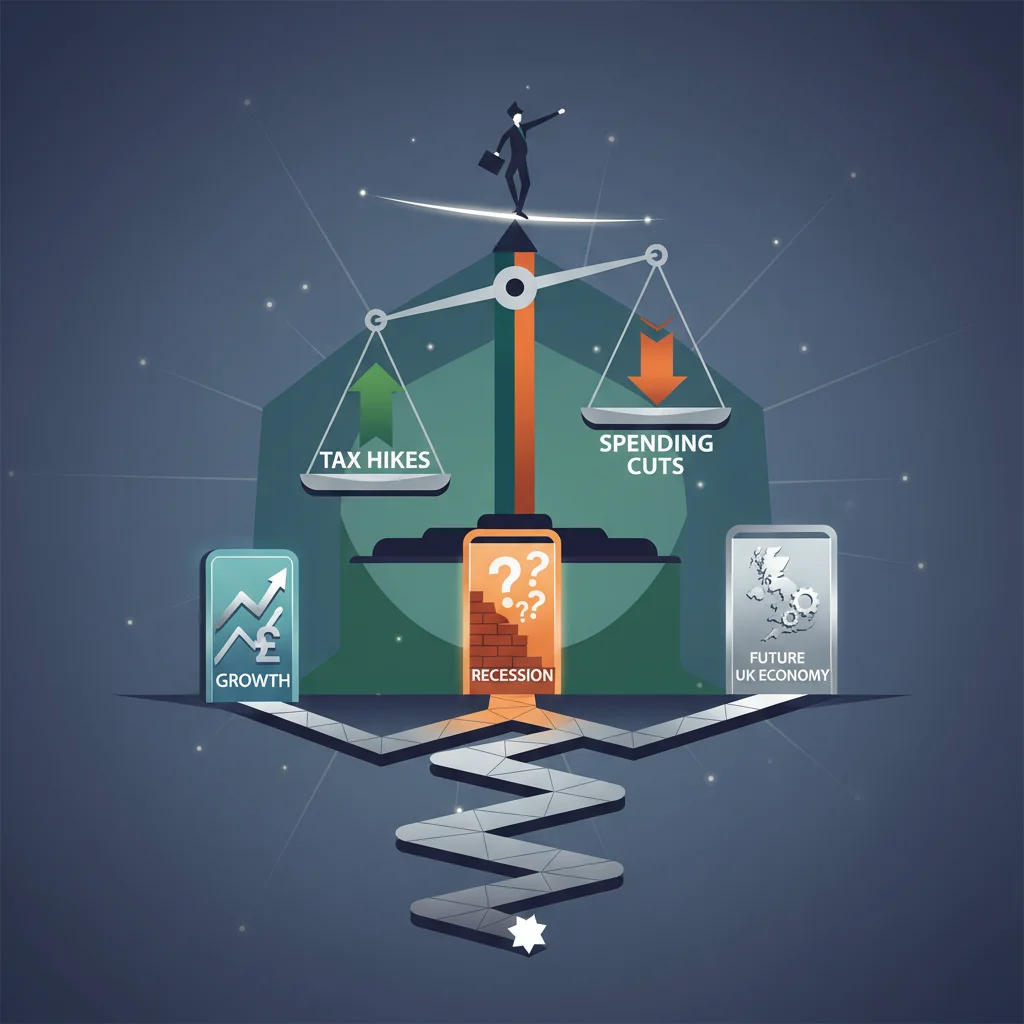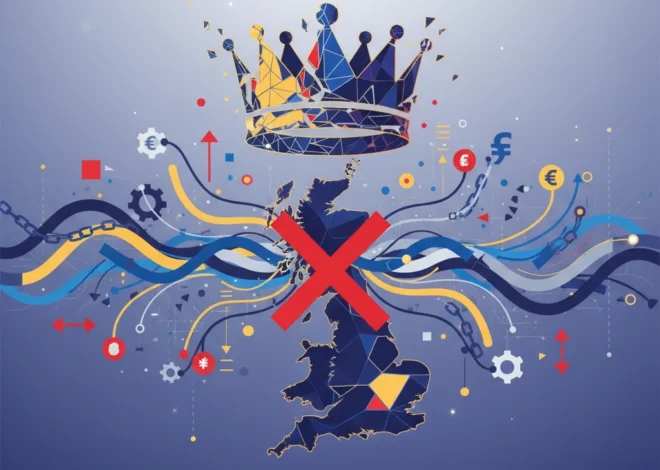
The November Budget Crossroads: Navigating Tax Hikes, Spending Cuts, and the Future of the UK Economy
The Chancellor’s Tightrope: Unpacking the High-Stakes 26 November Budget
The UK stands at a critical economic juncture. All eyes are on Chancellor Rachel Reeves as she prepares to deliver her inaugural Budget on 26 November, a statement that will set the fiscal tone for years to come. The central challenge is stark and unforgiving: how to stabilise the nation’s finances amidst sluggish growth, high national debt, and immense pressure on public services. The core of the dilemma, as reported by sources close to the Treasury, involves a difficult choice between tax rises and significant spending cuts—or, more likely, a painful combination of both (source).
For investors, business leaders, and financial professionals, this Budget is more than just a political event; it’s a pivotal moment that will directly influence the UK’s investment climate, the trajectory of the stock market, and the operational landscape for countless industries. This deep dive will explore the economic backdrop forcing these tough decisions, analyse the potential policy levers at the Chancellor’s disposal, and assess the far-reaching implications for the UK economy and your financial strategy.
The Economic Gauntlet: Why Tough Choices Are Inevitable
To understand the choices facing the Chancellor, one must first grasp the precarious state of the UK’s public finances. The nation is grappling with a legacy of economic shocks, including the pandemic, the energy crisis, and a prolonged period of high inflation. The result is a national debt that has swelled to levels not seen in decades, hovering around 98% of GDP according to the latest figures from the Office for Budget Responsibility (OBR).
This mountain of debt is not just a number on a spreadsheet; it has real-world consequences. Higher global interest rates mean the cost of servicing this debt has skyrocketed, consuming a larger slice of government revenue that could otherwise be spent on schools, hospitals, or infrastructure. The OBR forecasts that debt interest spending will remain historically high, creating a significant structural strain on the budget. This leaves the Chancellor with very little “fiscal headroom”—the wiggle room to increase spending or cut taxes without breaking her own fiscal rules.
Compounding this issue is the UK’s persistent struggle with low productivity and anemic economic growth. Without a robustly growing economy, the tax base stagnates, making it exponentially harder to pay down debt or fund public services. This is the tightrope the Chancellor must walk: implementing measures to restore fiscal discipline without choking off the fragile shoots of economic recovery.
The Hidden Inflation in Your Jewelry Box: How Record Gold Prices Are Redefining Luxury
The Chancellor’s Toolkit: A Deep Dive into Potential Policies
Faced with this daunting scenario, the Treasury is exploring a range of options, each with its own economic and political ramifications. The debate is broadly split between two camps: raising revenue through taxation or reducing expenditure through spending cuts.
1. The Tax Conundrum: Where Could the Burden Fall?
Tax rises are never popular, but they are a direct way to bolster government coffers. While headline increases to Income Tax or National Insurance are politically risky, several other avenues are reportedly under consideration. “Fiscal drag,” where tax-free allowances and thresholds are frozen, is a powerful stealth tax that has already pulled millions into higher tax brackets. Extending this freeze is one of the most likely options.
Other potential targets include wealth and capital. Changes to Capital Gains Tax (CGT) or Inheritance Tax (IHT) are often debated as ways to tax assets rather than income, though they face strong political opposition. A one-off windfall tax on the excess profits of banks or other sectors could also be on the table.
Below is a summary of potential tax measures and their implications:
| Potential Tax Measure | Description & Rationale | Potential Impact |
|---|---|---|
| Extend Freezes on Tax Thresholds | Continuing the freeze on personal allowance and higher-rate income tax thresholds. A form of “stealth tax.” | Raises significant revenue over time; impacts middle-income earners most; politically less explosive than direct rate hikes. |
| Capital Gains Tax (CGT) Reform | Aligning CGT rates with income tax rates or reducing the annual exemption. | Targets wealth from investing and property; could disincentivise investment and trigger asset sales before implementation. |
| Inheritance Tax (IHT) Overhaul | Closing loopholes or simplifying the system. A politically sensitive area. | Could raise billions but would be highly unpopular with aspirational voters and property owners. |
| New Windfall Taxes | Levies on sectors like banking or energy that have seen high profits. | Politically popular and raises funds quickly; risks deterring future investment in targeted sectors. |
2. The Spending Axe: Where Could Cuts Be Made?
The alternative to raising taxes is to cut public spending. This is arguably even more politically fraught, as it directly impacts the services people rely on. Major areas like the NHS, schools, and defence are “protected” to some extent, meaning the axe would have to fall disproportionately on “unprotected” departments. These include local government, the justice system, and transport—areas already feeling the strain after years of austerity.
The Institute for Fiscal Studies (IFS) has warned that existing spending plans already imply significant cuts for these unprotected departments, and any further reductions could have severe consequences for service quality. This presents a major challenge: delivering credible spending plans without triggering a public backlash or a visible decline in public services.
Market Reactions and the Investor’s Playbook
For those involved in finance and trading, the Budget’s details will be scrutinised for their impact on market sentiment and specific asset classes. The reaction of the Gilt market (UK government bonds) will be the first and most important indicator of credibility. A plan perceived as fiscally sound could see Gilt yields stabilise or fall, whereas a plan that spooks investors could trigger a sell-off, raising borrowing costs for the entire country.
The impact on the stock market will be more nuanced:
- Austerity-Heavy Budget: A focus on deep spending cuts could dampen domestic demand, hurting consumer-facing sectors like retail, hospitality, and housebuilding. However, it might be viewed positively by international investors, potentially strengthening the pound.
- Tax-Heavy Budget: Increases in corporation tax or taxes on dividends and capital gains would be a direct headwind for UK equities. Specific sectors like banking or energy could be hit by windfall taxes, while wealth management firms could suffer from changes to IHT or CGT.
- Pro-Growth Measures: Any surprises in the form of tax incentives for business investment, particularly in areas like green energy or financial technology (fintech), could create pockets of opportunity and boost specific stocks.
Investors should prepare for a period of volatility. A defensive posture, focusing on companies with strong balance sheets and international earnings, may be prudent. The rise of fintech platforms provides retail investors with sophisticated tools to analyse their portfolios and react swiftly to macroeconomic shifts, a crucial advantage in uncertain times.
The Stability Deficit: Why the UK's Constant Policy Tinkering is the Real Threat to its Economy
The Ripple Effect: From Westminster to Your Wallet
Ultimately, fiscal policy is not an abstract exercise in economics; it has a profound impact on households and businesses. A budget that squeezes disposable incomes through higher taxes or reduces the quality of public services will inevitably dampen consumer confidence and spending. This, in turn, affects business revenues and their appetite for investment and hiring.
The decisions made on 26 November will ripple through the entire financial ecosystem. The banking sector’s lending capacity could be influenced by the overall health of the economy, while the housing market is acutely sensitive to both consumer confidence and interest rate expectations, which are themselves influenced by government fiscal policy. The Bank of England’s Monetary Policy Committee will be watching closely, as the government’s tax and spend decisions will have a direct bearing on the path of inflation and future interest rate moves (source).
Conclusion: A Defining Moment for the UK Economy
The 26 November Budget is shaping up to be one of the most consequential fiscal events in recent memory. It is not merely an accounting exercise but a fundamental choice about the size and role of the state, the distribution of the tax burden, and the future direction of the UK economy. Chancellor Rachel Reeves faces the monumental task of charting a course toward fiscal sustainability without derailing a fragile recovery.
For everyone from the individual saver to the institutional investor, the message is clear: prepare for a period of change and potential austerity. The decisions made will create both challenges and opportunities, reshaping the landscape for investing, business, and personal finance for the remainder of this decade and beyond. The tightrope is set, and the world will be watching.


